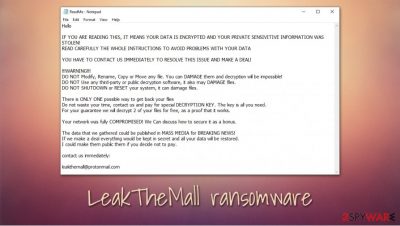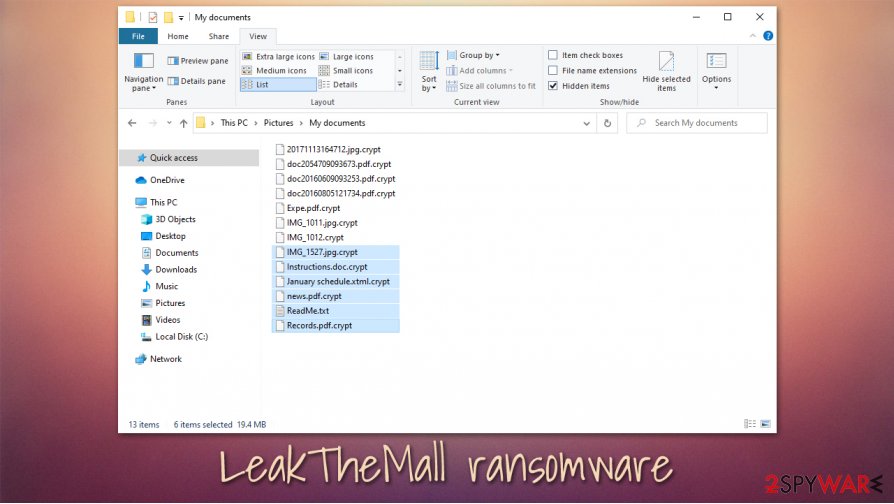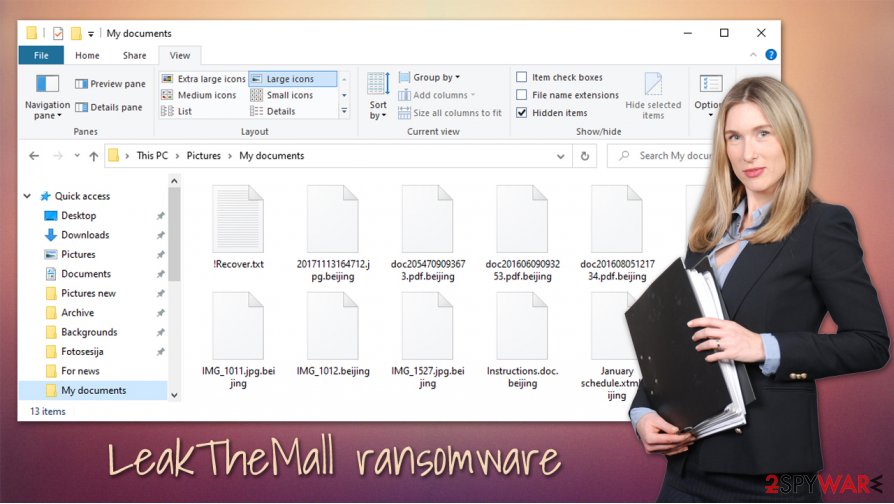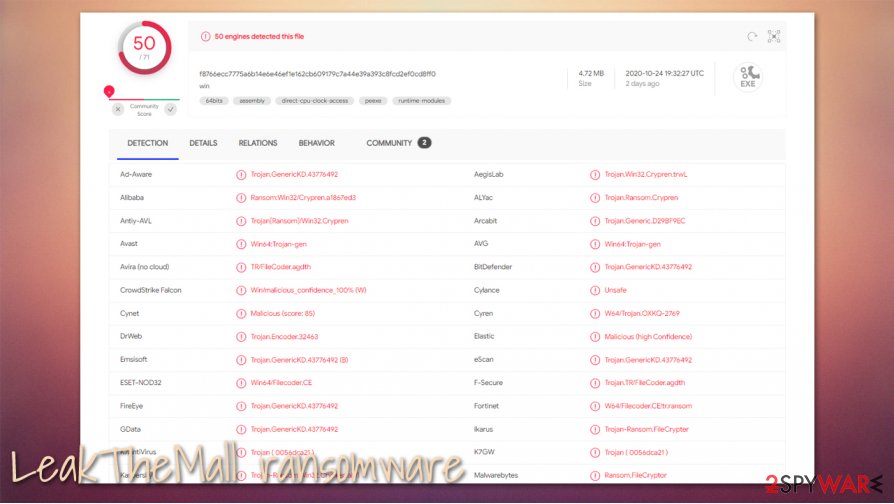Leakthemall ransomware removal - .crypt, .beijing and .montana files virus
Leakthemall virus Removal Guide
What is Leakthemall ransomware?
Leakthemall ransomware in a newly discovered virus that will change your file names to .crypt, .montana or .beijing

LeakTheMall ransomware (aka LeakThemAll) is a data locking virus that was first discovered by cybersecurity researcher Amigo-A.[1] If your computer gets infected by this malware, your data will be encrypted with a “.crypt,” “.montana,” or “.beijing” extensions. For example, “a.pdf” would become “a.pdf.crypt,” b.pdf” as “b.pdf.crypt,” and exactly the same renaming applies to the Montana virus and Beijing virus, which will apply .montana and .beijing extensions accordingly.
When the encryption[2] is complete, ransom note files appear in the affected folders. The .crypt virus will give you a ReadMe.txt file with further instructions to decrypt your data. Beijing virus will show up !Recover.txt file and Montana virus will display !Help!.txt. Inside, the developers of Leakthemall ransomware are asking for a ransom and provide further instructions on how to proceed to unlock your files.
| NAME | LeakTheMall ransomware, LeakThemAll virus, Beijing virus, Montana virus |
|---|---|
| File extension | .crypt , .montana , .beijing |
| Ransom file name | ReadMe.txt , !Help!.txt , !Recover.txt |
| Distribution | Spam email and its malicious attachments, spoof downloads, botnets, trojans, fake updates, repackaged and infected installers |
| Contact email | leakthemall@protonmail.com, montanarecover@mail.ee or montanarecover@cock.li, beijing520@aol.com, beijing520@cock.li |
| Damage | Encrypted computer data without the ability to use it without paying a ransom or encrypting the files |
| Issues | Victims cannot open files. Computer data is encrypted and an extension (.crypt / .beijing / .montana) is added to all files. Ransom file (ReadMe.txt , !Help!.txt or !Recover.txt) appears on the desktop. |
| Recommend removal | To find and remove possible ransomware infection please use anti-malware like SpyHunter 5Combo Cleaner |
| System repair | Computer infections might result in serious damage to your system files and interrupt the usual way your PC works. We recommend using a trusted PC repair tool line FortectIntego to get your PC working normally again. |
The fraudsters will ask you to contact them via email leakthemall@protonmail.com for the crypt virus, montanarecover@mail.ee, or montanarecover@cock.li for the Montana virus, and beijing520@aol.com or beijing520@cock.li for the Beijing virus decryption.
If you proceed with the instructions, they might unlock a couple of files just to show the victim that decryption is possible. While encryption of your files is in progress, some of your data might have been stolen, and if you refuse to cooperate with cybercriminals, they will threaten to publicize the content of the stolen data.
However, LeakTheMall ransomware removal should be performed regardless if you agree to pay or not. We recommend using powerful anti-malware, such as SpyHunter 5Combo Cleaner or Malwarebytes, for the purpose. Later, you can employ FortectIntego to fix potential damage caused to Windows system files for full OS recovery.

Do not pay the ransom to unlock .crypt, .montana or .beijing files – look for alternatives instead
Malware developers warn victims that any modifications done to the files (copying, renaming, etc.), any tries of decryption with third-party software, or a computer shutdown/restart might cause them to be non-decryptable. Hence, your data could be permanently lost, unless the malware itself isn't completed and has serious flaws,[3] decryption without the key from the ransomware developers isn't possible.
Despite that, it is strongly recommended not to comply with the ransom demands because even if the money is paid, users might still not receive the decryption key. Your data would still be encrypted, but your wallet would be a bit lighter. The ransomware has to be deleted from the system to prevent its further encryption. Unfortunately, this won't decrypt your files. The only way to recover your data is if you've made a backup on a separate location prior to the contamination.
Below is the message of the LeakTheMall ransomware with .crypt file extension ransom note ReadMe.txt reads:
Hello
IF YOU ARE READING THIS, IT MEANS YOUR DATA IS ENCRYPTED AND YOUR PRIVATE SENSIVITIVE INFORMATION WAS STOLEN!
READ CAREFULLY THE WHOLE INSTRUCTIONS TO AVOID PROBLEMS WITH YOUR DATAYOU HAVE TO CONTACT US IMMEDIATELY TO RESOLVE THIS ISSUE AND MAKE A DEAL!
!!!WARNING!!!
DO NOT Modify, Rename, Copy or Move any file. You can DAMAGE them and decryption will be impossible!
DO NOT Use any third-party or public decryption software, it also may DAMAGE files.
DO NOT SHUTDOWN or RESET your system, it can damage files.There is ONLY ONE possible way to get back your files
Do not waste your time, contact us and pay for special DECRYPTION KEY. The key is all you need.
For your guarantee we will decrypt 2 of your files for free, as a proof that it works.Your network was fully COMPROMISED! We Can discuss how to secure it as a bonus.
The data that we gathered could be published in MASS MEDIA for BREAKING NEWS!
If we make a deal everything would be kept in secret and all your data will be restored.
I could make them public them if you decide not to pay.contact us immediately:
leakthemall@protonmail.com
The LeakTheMall ransomware with .beijing file extension will show the following ransom note !RECOVER.txt:
ALL YOUR DATA WAS ENCRYPTED
Whats Happen?
Your files are encrypted, and currently unavailable. You can check it: all files on you computer has extension .beijing
By the way, everything is possible to restore, but you need to follow our instructions. Otherwise, you cant return your data (NEVER).
What guarantees?
It's just a business. We absolutely do not care about you and your deals, except getting benefits.
If we do not do our work and liabilities – nobody will not cooperate with us.
It's not in our interests.
If you will not cooperate with our service – for us, its does not matter. But you will lose your time and data, cause just we have the private key.
In practise – time is much more valuable than money.
What should You include in your message?
1. Your country and city
2. This TXT file
3. Some files for free decryption
Free decryption as guarantee!
Before paying you send us up to 2 files for free decryption.
Send pictures, text files. (files no more than 1mb)
If you upload the database, your price will be doubled
Contacts:
beijing520@aol.com
beijing520@cock.liYour Personal ID: –

LeakThemAll ransomware with .montana file mark will give the !HELP!.txt ransom note:
Hello.
If you are reading this, it means your data is encrypted and your private sensivitive information was stolen!
Read carefully the whole instructions to avoid problems with your data.
You have to contact us immediately to resolve this issue and make a deal!!!!WARNING!!!
DO NOT modify, rename, copy or move any file. You can DAMAGE them and decryption will be impossible!
DO NOT use any third-party or public decryption software, it also may DAMAGE files.There is ONLY ONE possible way to get back your files.
Do not waste your time, contact us and pay for special DECRYPTION TOOL. The tool is all you need.
For your guarantee we can decrypt 2 of your text or image files for free, as a proof that it works.Your network was fully COMPROMISED! We can discuss how to secure it as a bonus.
The data that we gathered could be published in MASS MEDIA for BREAKING NEWS!
If we make a deal everything would be kept in secret and all your data will be restored.
I could make them public them if you decide not to pay.
Contact us immediately:
montanarecover@mail.ee
montanarecover@cock.li
There are many other ransomware viruses such as Clay, Conti, or the notorious new Stop/Djvu ransomware version – Mmpa virus. These programs operate the same way – encryption and ransom demand. They differ in just two aspects – the cryptographic algorithm used and the amount of money asked for the decryption code as a ransom. To avoid dealing with this kind of cybercriminals, it is very important to keep backups in different locations, such as removable storage devices, remote servers, etc.
Ways to decrypt your files and prevent future ransomware attacks
There are numerous ways for your system to get infected by ransomware or some other type of malware. It is usually acquired via spam mail, “cracking” tools, trojans, etc. Scam mail usually contains download links of malicious software, or the infection files could just be added to the email as attachments. There are various ways of what these files might look like (i.e., .exe files, JavaScript, MS Office, .pdf, etc.), and the minute they're opened, the infection on the user begins.
Trojans are other threats that cybercriminals might distribute in such a way- it is malicious software that can enable cyber-criminals to steal your sensitive data, gain backdoor access to your system, download additional malware, etc. “Cracking” tools are used to illegally activate licensed software, but instead of doing that, it might install some malware.

Users should never open irrelevant, fishy looking emails. And especially never open any attachments received in emails from suspicious, unknown senders. All downloads and software updates should be done only via trustworthy sources. Usage of “cracking” tools is not recommended as it could lead to a system infection. Computer users should obtain legitimate antivirus software, keep it up-to-date, and regularly scan their computer systems. Keep backups of data in different locations. If your system is infected with the ransomware, we recommend using them!
Keep in mind that you have to remove LeakTheMall ransomware with an anti-malware tool (such as SpyHunter 5Combo Cleaner or Malwarebytes) before you attempt to use backups or other data recovery solutions. Otherwise, all your files will be encrypted repeatedly.
After LeakTheMall ransomware removal, you can then employ alternative data recovery methods we list below. Keep in mind that they are likely not to work, but since there is a chance that malware failed to perform its certain functions, you might be able to restore all your data for free. In other words, you will never know before you try. Note that it is advised to copy the encrypted files to another medium before doing so.
Getting rid of Leakthemall virus. Follow these steps
Manual removal using Safe Mode
If your security software is being tampered with by the LeakTheMall virus, access Safe Mode with Networking:
Important! →
Manual removal guide might be too complicated for regular computer users. It requires advanced IT knowledge to be performed correctly (if vital system files are removed or damaged, it might result in full Windows compromise), and it also might take hours to complete. Therefore, we highly advise using the automatic method provided above instead.
Step 1. Access Safe Mode with Networking
Manual malware removal should be best performed in the Safe Mode environment.
Windows 7 / Vista / XP
- Click Start > Shutdown > Restart > OK.
- When your computer becomes active, start pressing F8 button (if that does not work, try F2, F12, Del, etc. – it all depends on your motherboard model) multiple times until you see the Advanced Boot Options window.
- Select Safe Mode with Networking from the list.

Windows 10 / Windows 8
- Right-click on Start button and select Settings.

- Scroll down to pick Update & Security.

- On the left side of the window, pick Recovery.
- Now scroll down to find Advanced Startup section.
- Click Restart now.

- Select Troubleshoot.

- Go to Advanced options.

- Select Startup Settings.

- Press Restart.
- Now press 5 or click 5) Enable Safe Mode with Networking.

Step 2. Shut down suspicious processes
Windows Task Manager is a useful tool that shows all the processes running in the background. If malware is running a process, you need to shut it down:
- Press Ctrl + Shift + Esc on your keyboard to open Windows Task Manager.
- Click on More details.

- Scroll down to Background processes section, and look for anything suspicious.
- Right-click and select Open file location.

- Go back to the process, right-click and pick End Task.

- Delete the contents of the malicious folder.
Step 3. Check program Startup
- Press Ctrl + Shift + Esc on your keyboard to open Windows Task Manager.
- Go to Startup tab.
- Right-click on the suspicious program and pick Disable.

Step 4. Delete virus files
Malware-related files can be found in various places within your computer. Here are instructions that could help you find them:
- Type in Disk Cleanup in Windows search and press Enter.

- Select the drive you want to clean (C: is your main drive by default and is likely to be the one that has malicious files in).
- Scroll through the Files to delete list and select the following:
Temporary Internet Files
Downloads
Recycle Bin
Temporary files - Pick Clean up system files.

- You can also look for other malicious files hidden in the following folders (type these entries in Windows Search and press Enter):
%AppData%
%LocalAppData%
%ProgramData%
%WinDir%
After you are finished, reboot the PC in normal mode.
Remove Leakthemall using System Restore
System Restore can be used in order to delete the malicious software from your machine:
-
Step 1: Reboot your computer to Safe Mode with Command Prompt
Windows 7 / Vista / XP- Click Start → Shutdown → Restart → OK.
- When your computer becomes active, start pressing F8 multiple times until you see the Advanced Boot Options window.
-
Select Command Prompt from the list

Windows 10 / Windows 8- Press the Power button at the Windows login screen. Now press and hold Shift, which is on your keyboard, and click Restart..
- Now select Troubleshoot → Advanced options → Startup Settings and finally press Restart.
-
Once your computer becomes active, select Enable Safe Mode with Command Prompt in Startup Settings window.

-
Step 2: Restore your system files and settings
-
Once the Command Prompt window shows up, enter cd restore and click Enter.

-
Now type rstrui.exe and press Enter again..

-
When a new window shows up, click Next and select your restore point that is prior the infiltration of Leakthemall. After doing that, click Next.


-
Now click Yes to start system restore.

-
Once the Command Prompt window shows up, enter cd restore and click Enter.
Bonus: Recover your data
Guide which is presented above is supposed to help you remove Leakthemall from your computer. To recover your encrypted files, we recommend using a detailed guide prepared by 2-spyware.com security experts.If your files are encrypted by Leakthemall, you can use several methods to restore them:
Data Recovery Pro is a powerful tool that might help some victims
This tool might lookup and recover some working copies from your hard drive.
- Download Data Recovery Pro;
- Follow the steps of Data Recovery Setup and install the program on your computer;
- Launch it and scan your computer for files encrypted by Leakthemall ransomware;
- Restore them.
Windows Previous Versions Feature might be useful
With this feature, you can restore files one-by-one. This would only work if malware failed to delete Shadow Volume Copies, however.
- Find an encrypted file you need to restore and right-click on it;
- Select “Properties” and go to “Previous versions” tab;
- Here, check each of available copies of the file in “Folder versions”. You should select the version you want to recover and click “Restore”.
ShadowExplorer might work for you
You can employ ShadowExplorer to automate the recovery process (again, it only works if Shadow Copies were not removed).
- Download Shadow Explorer (http://shadowexplorer.com/);
- Follow a Shadow Explorer Setup Wizard and install this application on your computer;
- Launch the program and go through the drop down menu on the top left corner to select the disk of your encrypted data. Check what folders are there;
- Right-click on the folder you want to restore and select “Export”. You can also select where you want it to be stored.
No decryption tool is currently available
Finally, you should always think about the protection of crypto-ransomwares. In order to protect your computer from Leakthemall and other ransomwares, use a reputable anti-spyware, such as FortectIntego, SpyHunter 5Combo Cleaner or Malwarebytes
How to prevent from getting ransomware
Stream videos without limitations, no matter where you are
There are multiple parties that could find out almost anything about you by checking your online activity. While this is highly unlikely, advertisers and tech companies are constantly tracking you online. The first step to privacy should be a secure browser that focuses on tracker reduction to a minimum.
Even if you employ a secure browser, you will not be able to access websites that are restricted due to local government laws or other reasons. In other words, you may not be able to stream Disney+ or US-based Netflix in some countries. To bypass these restrictions, you can employ a powerful Private Internet Access VPN, which provides dedicated servers for torrenting and streaming, not slowing you down in the process.
Data backups are important – recover your lost files
Ransomware is one of the biggest threats to personal data. Once it is executed on a machine, it launches a sophisticated encryption algorithm that locks all your files, although it does not destroy them. The most common misconception is that anti-malware software can return files to their previous states. This is not true, however, and data remains locked after the malicious payload is deleted.
While regular data backups are the only secure method to recover your files after a ransomware attack, tools such as Data Recovery Pro can also be effective and restore at least some of your lost data.
- ^ Amigo-A. Twitter. Social network.
- ^ Encryption. Wikipedia. The free encyclopedia.
- ^ Thomas Holt. What are software vulnerabilities, and why are there so many of them?. The Conversation..





















